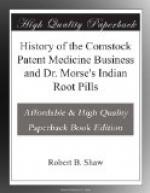Meanwhile the civil litigation respecting the division of the assets of the old partnership, broken down into a welter of complaints and countercomplaints, dragged on until 1852. No document reporting the precise terms of the final settlement was discovered, although the affair was obviously compromised on some basis, as the surviving records do speak of a division of the stock in New York City and at St. Louis. The original premises at 57 John Street were left in the possession of Lucius. In this extensive litigation, J. Carlton and George were represented by the law firm of Allen, Hudson & Campbell, whose bill for $2,132 they refused to pay in full, so that they were, in turn, sued by the Allen firm. Some of the lengthy evidence presented in this collection suit enlightened further the previous contest with Lucius. He was described as an extremely difficult person: “at one time the parties came to blows—and G.W. gave the Dr. a black eye.” The action by the law firm to recover its fee was finally compromised by the payment of $1,200 in January 1854.
The settlement of the affairs of Comstock & Co. Brothers failed to bring peace between Lucius and the others. The rival successor firms continued to bicker over sales territory and carried the battle out into the countryside, each contending for the loyalty of former customers. Letters and circulars attacking their opponents were widely distributed by both parties. As late as December 1855, more than four years after the event, Lucius was still complaining, in a series of printed circulars, about the “robbery” of his mail from the post office, although the case had been dismissed by the court.
But somehow the new firm of Comstock & Brother triumphed over Comstock & Co., for in the summer of 1853 Lucius found it necessary to make an assignment of all of his assets to his creditors. Thereafter he removed his business from John Street to 45 Vesey Street, in the rear of St. Paul’s Churchyard, but although he put out impressive new handbills describing his firm as “Wholesale Chemists, Druggists and Perfumers,” he apparently no longer prospered in the drug trade, for old New York City directories show that he shortly turned his main energies to the practice of law. Versatile as he was, Lucius entered the Union Army as a surgeon during the Civil War, and upon his return he resumed his legal career, continuing to his death in 1876. Aside from his role in the Comstock medicine business, Lucius also rates a footnote in United States political history as the foreman of the grand jury that indicted Boss Tweed in 1872.
A New Partnership Formed
The two proprietors of Comstock & Brother at 9 John Street were the brothers George Wells and J. Carlton Comstock. At the time of the events just related, their nephew, William Henry Comstock, was an employee, but not a partner, of the firm (he was the “clerk” who had removed the controversial letters from the post office). This partnership was terminated by the death on September 17, 1853, of J. Carlton Comstock, the inventor of the veterinary medicines.




